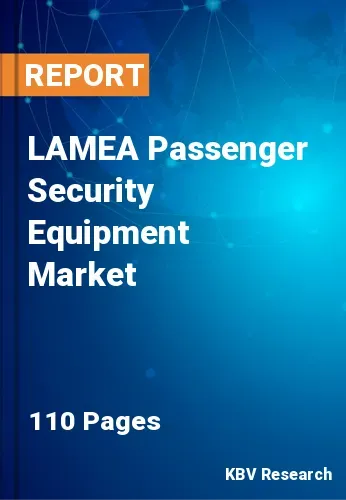The Latin America, Middle East and Africa Passenger Security Equipment Market would witness market growth of 11.0% CAGR during the forecast period (2022-2028).
Magnetic fields are used by metal detectors to assist identify metal objects. The current flow via cables or electronic items produces magnetic fields. Metal detectors use a short pulse of electrical charge to create a magnetic field. If there are any metal objects nearby, including a watch or a belt buckle, the magnetic force would be partially reflected in the machine. The system detects the return signal and emits a beeping noise to inform the TSA agent. Small amounts of metal, such as the zipper on jeans or small earrings, are ignored by metal detectors. Non-ionizing radiation is used in some equipment. Non-ionizing radiation has enough energy to vibrate or move the atoms in a molecule but not enough to remove electrons. Metal detectors and millimetre wave equipment in airports deliver low-energy, non-ionizing radiation across scanned surfaces. The energy that recovers from the scanned surface can either display the objects that are present or generate an image that TSA personnel can utilize to display items that require further inspection.
One of the most essential variables that determine air transport safety and security is passenger and luggage safety in airport screening systems. It prohibits the boarding of an airplane with elements that could be used to perform an act of unlawful interference. X-ray screening machines, walk-through metal detectors, and specialized software make up the security screening system. The person the security screener is, nonetheless, an important component of the security screening system.
The General Civil Aviation Authority (GCAA) has approved the implementation of increased security measures at international airports in the United Arab Emirates. With effect from May 31, 2007, passengers would be limited in the number of aerosols, liquids, and gels that they can bring into the aircraft cabin in their luggage. The market in this region is likely to be driven by substantial growth in investment aimed at enticing tourists to help the region's tourism sector expand. Additionally, due to an increase in air passenger traffic, the industry in the rest of the world is expected to develop somewhat. The security measures are based on ICAO recommendations and aim to align the UAE's aviation security methods and processes with those already in place in various emerging countries, including regional Gulf states.
Passengers would only be allowed to take fluids such as perfume, toiletries, shaving foam, deodorant, and lip balm across airport immigration screening checkpoints in cabin baggage from May 31, 2007, if they are in containers no larger than 100ml apiece. The liquid products to be taken in the airplane cabin must fit easily into a single clear, re-sealable container should not be larger than 1 litre or roughly 20cm × 20cm, and must fit within the cabin baggage allowance.
The Brazil market dominated the LAMEA Passenger Security Equipment Market by Country in 2021, and would continue to be a dominant market till 2028; thereby, achieving a market value of $2,381.1 million by 2028. The Argentina market is poised to grow at a CAGR of 11.6% during (2022 - 2028). Additionally, The UAE market would showcase a CAGR of 10.7% during (2022 - 2028).
Based on Offering, the market is segmented into Equipment and Services. Based on Transport Infrastructure, the market is segmented into Airport, Train Stations, Bus Stations, and Seaports. Based on Type, the market is segmented into Fire Safety & Detection System, Explosive Detection System, Intrusion Detection & Prevention System, Baggage Inspection System, People Screening Systems, Video Surveillance, and Others. Based on countries, the market is segmented into Brazil, Argentina, UAE, Saudi Arabia, South Africa, Nigeria, and Rest of LAMEA.
Free Valuable Insights: The Global Passenger Security Equipment Market is Predict to reach $105.9 Billion by 2028, at a CAGR of 8.6%
The market research report covers the analysis of key stake holders of the market. Key companies profiled in the report include Siemens AG, L3Harris Technologies, Inc., Smiths Group PLC, Autoclear LLC, Kapsch TrafficCom AG, Honeywell International, Inc., Axis Communications AB, Bosch Security Systems GmbH, Rapiscan Systems, Inc., and SITA.
By Offering
By Transport Infrastructure
By Type
By Country

Our team of dedicated experts can provide you with attractive expansion opportunities for your business.

